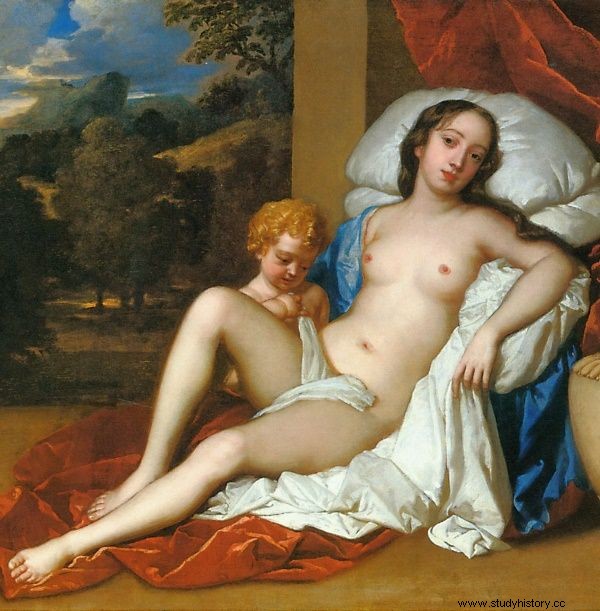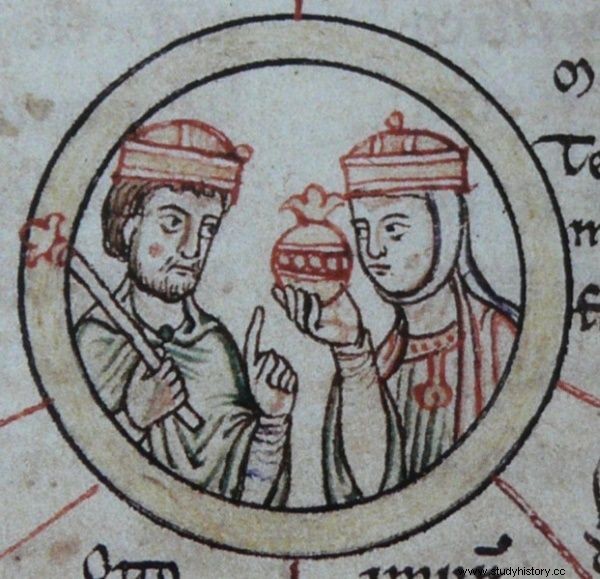Popular culture instilled in us a very specific image of weddings in the Middle Ages. The husband is well over forty, the wife is only after her twelfth or thirteenth birthday. She is still playing with her favorite doll and has just dropped the scrap of her mother's dress from her hands. Just like Jagiełło and Jadwiga. Such relationships did happen. Question:was that a rule or a rather infamous exception?
There are many examples of enormous age differences. The famous Polish queen Bona Sforza may have been an adult, but she married a man twice her age. Two of her daughters had married elderly provincial rulers and were expressly widowed. Characteristically, it is easiest to point to cases from the modern times or from the late medieval decades.
By comparison, in these supposedly darkest ages, a thousand or more years ago, marriage was approached in a way ... very similar to today's . Picking up teenage girls and men struggling with the first signs of senile impotence on the wedding carpet was rare, and was strongly condemned.

A girl and a boy on a wedding carpet. We still instinctively assume that this is what it was like a millennium ago ...
Good advice from Doda
The groom and the bride "should not be different, but of the same age," stated the bishops at the council in Fréjus during the reign of Charlemagne. The shepherds of the Frankish church warned not only against relationships in which the fiancée is a teenager, but also against dangerous cases where a mature woman marries a boy, which exposes her to sexual promotion from her brothers-in-law or father-in-law. The golden mean was recommended.
Doda, a mysterious Frankish aristocrat and author of one of the first medieval textbooks of good manners, also supported him. In Liber Manualis (prepared by the way as a gift for one of her sons) the woman explained that the wedding should take place only at the "perfect time". This term, found in the writings of philosophers and legal codes since antiquity, was meant to be exactly half of life - the moment when puberty ends and aging inevitably begins.

King Charles II Stuart's teenage mistress. However, this is already the 17th century, not the Middle Ages!
Extant early medieval treatises suggest that the "perfect time" is twenty to twenty years. But certainly not less. And it seems that the people alive at the time did really respect this principle.
Weddings as in the PRL ... in the times of Charlemagne
Where records of baptisms, weddings and funerals have survived, historians have consistently followed the same pattern of conduct. Both men and women in Charlemagne's state waited until they were in their twenties at least to get married. And when they got married, they were of a very similar age, regardless of gender.
One could, of course, try to challenge these figures by saying that the habits of the inhabitants of villages and towns have little to do with the rituals of the elites. In this case, however, there is no basis for such criticism. While the Church did not mind marrying even twelve-year-old girls, this permission was rarely used. Even at the height of power. Kings and princes married like the rest of the early medieval world.
Statistics don't lie
With regard to the first Piasts, it is difficult to come up with details, because we do not know the daily or annual dates of birth of any of their wives. The same applies, for example, to the Přemyslids, the family from which our first historical duchess came. Both Poland and the Czech Republic, however, gravitated towards the German models of political culture in the early Middle Ages.
And good, because much more is known about the marriages of the local Ludolfing dynasty.
This article has more than one page. Please select another one below to continue reading.Attention! You are not on the first page of the article. If you want to read from the beginning click here.
The kings and emperors of the ruling family from 919 to 1024 had a total of six legal unions. In four of them it is possible to at least approximately estimate the age of the bride. Another figure should be taken into account:the would-be wife of Otto III. Although the wedding did not take place due to the premature death of the emperor, negotiations were completed and the Byzantine princess Zoe was already on her way to Germany.
Of these women, was not under twenty at the time of marriage. Their average age, on the other hand, was over twenty-three.

It is hard to find a better example than Henry I - the founder of the Ludolfing dynasty. His first wedding was to a woman in his early 30s.
An exception proves the rule?
The only case of marrying a really young partner would be, at best, with Otto II and another Byzantine princess, Theophano. The date of birth of the latter is unknown. Some sources say she was under fifteen; according to others - she was seventeen. Even if the first version is true, it would only be the exception that proves the rule.
As a rule, the German monarchs did not mind marrying women in their twenties or even thirty. They certainly didn't think that the woman in her 20s was old anymore.

Learn about the fascinating history of women who built Poland in the darkness of the Middle Ages. Ruthless, ambitious, talented. Kamil Janicki's "Iron Ladies" is now on sale !
If this was the case in the center of Latin civilization, it is hard to suspect that the rulers of the Central European state had a completely different approach to marriage policy. The custom of early weddings entered the mainstream much later. But that is a topic for a separate article.
***
Are you fed up with the powdered and polished history of the beginnings of Poland? We too. Kamil Janicki presents the painfully true version of events. Massive crimes, slave trade, the realities of life beyond the borders of civilization and the brutal games of early medieval courts. Here is a fascinating story about the ruthless, ambitious and power-hungry wives of the first Piasts. And about the country they took part in building.
Sources:
The article is based on the literature and materials collected by the author during the work on the book "Iron Ladies. The Women Who Built Poland ” . Find out more by clicking HERE . Selected bibliographic items below:
- D. Herlihy, Medieval Households , Cambridge 2009.
- M.A. Mayeski, Dhuoda. Ninth-Century Mother and Theologian , Scranton 1995.
- J. Nikodem, Jadwiga. King of Poland , Wrocław 2009.
- J.J. Norwich, Byzantium. The Apogee , London 1993.
- H.K. Schulze, Die Heiratsurkunde der Kaiserin Theophanu. Die griechische Kaiserin und das römisch-deutsche Reich 972-991 , Hannover 2007.
